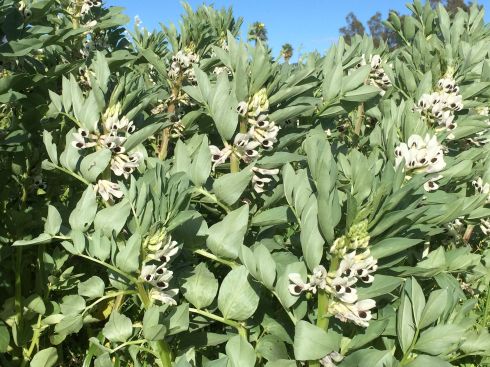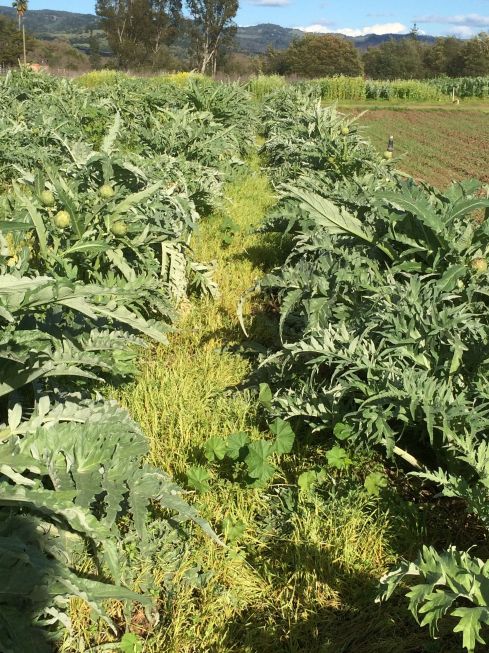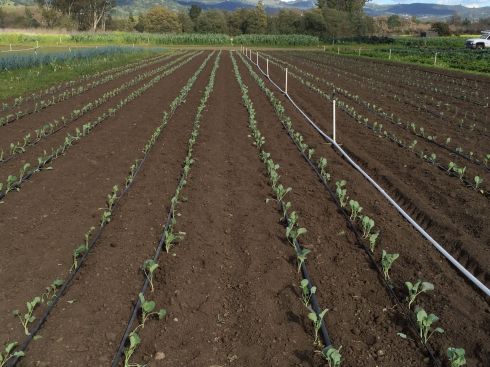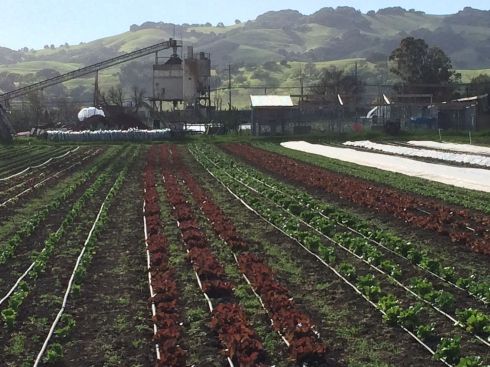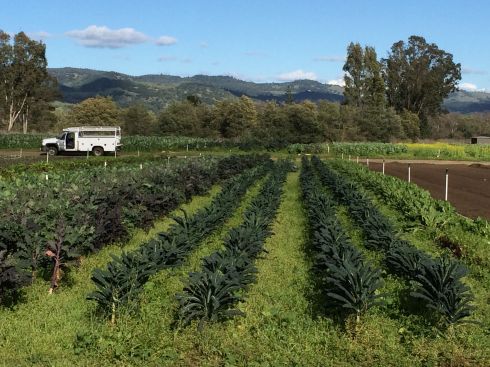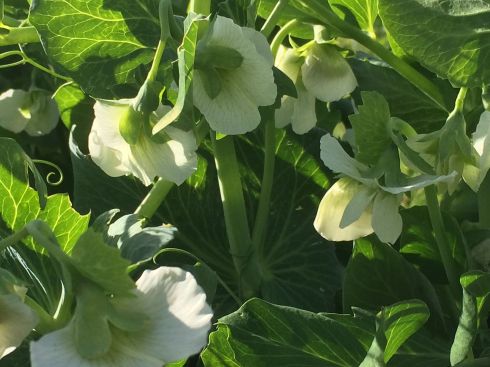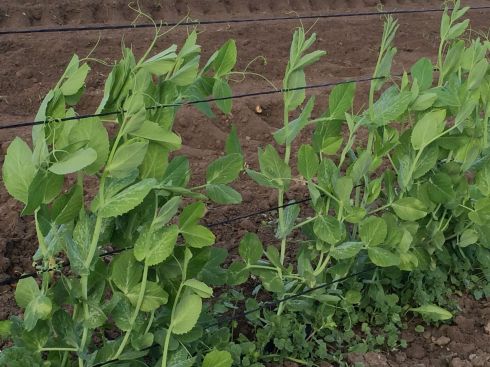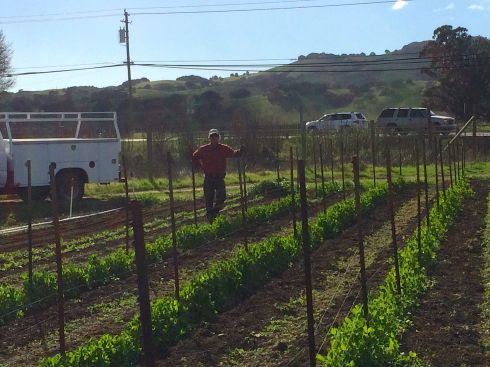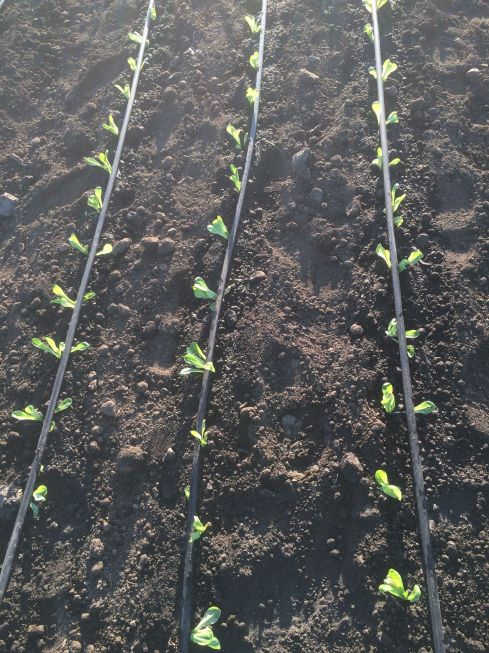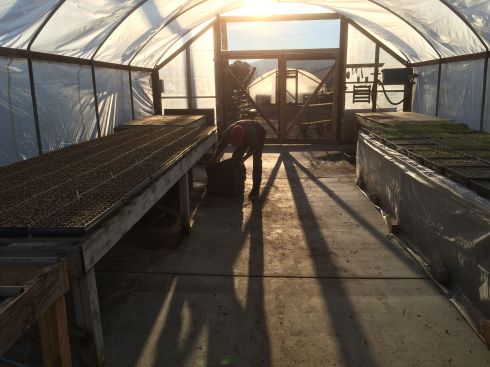One requirement for a good farmer is to be able to juggle many things. Today, as I walked around the farm, I noticed the following:
 Shallots have been pulled and are drying in the field. There they will stay for a week or so, then go into shade for further drying before long storage inside. These shallots were planted from seed in the greenhouse in February and planted in the field April. Fresh shallot harvest began about a month ago.
Shallots have been pulled and are drying in the field. There they will stay for a week or so, then go into shade for further drying before long storage inside. These shallots were planted from seed in the greenhouse in February and planted in the field April. Fresh shallot harvest began about a month ago.
 Lots of ground is “open” right now, either furrowed as shown on the left side of the sprinkler line or bedded up and ready for new plantings, as shown on the right. The furrowing step helps the soil dry more thoroughly and helps the breakdown of the previous crop residue. When the soil is at optimum moisture levels compost is added and it is shaped into beds. After bedding up, organic fertilizer is worked into the beds and given a chance to assimilate into the soil before planting. Beds are irrigated to promote breakdown of previous crops and organic fertilizers.
Lots of ground is “open” right now, either furrowed as shown on the left side of the sprinkler line or bedded up and ready for new plantings, as shown on the right. The furrowing step helps the soil dry more thoroughly and helps the breakdown of the previous crop residue. When the soil is at optimum moisture levels compost is added and it is shaped into beds. After bedding up, organic fertilizer is worked into the beds and given a chance to assimilate into the soil before planting. Beds are irrigated to promote breakdown of previous crops and organic fertilizers.
 The next crop of carrots is coming along. We’re glad the huge carrots are still tasty.
The next crop of carrots is coming along. We’re glad the huge carrots are still tasty.  It’s a trick to estimate how many carrots to plant to make sure there are enough until the next crop comes along. Looks like these 4 beds will be ready when we need them. About the time one crop is nearing picking the next crop needs to be planted. At approximately 20 seeds per foot, a typical planting of 4 x 200’ beds requires 50,000 carrot seeds!
It’s a trick to estimate how many carrots to plant to make sure there are enough until the next crop comes along. Looks like these 4 beds will be ready when we need them. About the time one crop is nearing picking the next crop needs to be planted. At approximately 20 seeds per foot, a typical planting of 4 x 200’ beds requires 50,000 carrot seeds!
 Paul has planted a smattering of beans this year, several varieties, not a lot of any one. They will go into our CSA boxes. Anything extra will show up at the farmers markets. One variety is called Jade, a typical snappy green bean. Rocdor is a yellow wax bean with a very bad name. And Jumbo is a large Romano-type. They are flowering and we may have our first Jade crop next week.
Paul has planted a smattering of beans this year, several varieties, not a lot of any one. They will go into our CSA boxes. Anything extra will show up at the farmers markets. One variety is called Jade, a typical snappy green bean. Rocdor is a yellow wax bean with a very bad name. And Jumbo is a large Romano-type. They are flowering and we may have our first Jade crop next week.
 The new field is getting outfitted with pipe and plants. Expecting a wave of grass and new weeds, Paul spaced these artichoke rows at twice normal to deal with the extra work on weeds. In fall, he’ll plant a crop like fava beans or broccoli deCicco between these chokes.
The new field is getting outfitted with pipe and plants. Expecting a wave of grass and new weeds, Paul spaced these artichoke rows at twice normal to deal with the extra work on weeds. In fall, he’ll plant a crop like fava beans or broccoli deCicco between these chokes.
 For those of you in the area, Paul’s Produce is part of the Saturday morning (9 am until 1 pm) farmers’ market at the Sonoma Community Center, giving folks another opportunity to buy our produce. Come down and meet our new employee, Teresa Alampur. She has a multi-cuisine background (think Thai and Indian) and a deep love for yoga. We’re lucky to have her enthusiasm and energy join ours.
For those of you in the area, Paul’s Produce is part of the Saturday morning (9 am until 1 pm) farmers’ market at the Sonoma Community Center, giving folks another opportunity to buy our produce. Come down and meet our new employee, Teresa Alampur. She has a multi-cuisine background (think Thai and Indian) and a deep love for yoga. We’re lucky to have her enthusiasm and energy join ours.

